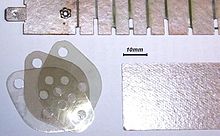Artificial mica
Artificial mica is made from split, broken or ground mica .
The mica fragments are pressed into various shapes using synthetic resins as binders and then baked.
Resin-rich mica films are processed in hot presses, while low-resin or porous tapes are manufactured using vacuum-pressure impregnation (VPI process).
Mica is a mineral with excellent insulating properties and can be split into micrometer-thin layers. As such, it can be processed into thin, flexible and translucent mica foils as well as multi-layered into robust, heat-resistant and electrically insulating mica sheets or mica paper.
Temperature resistance, resistance to solvents and dielectric properties of synthetic mica are inferior to those of pure mica, but sufficient for many applications, especially in the electrical industry, where it can replace asbestos, ceramics, glass fibers / fleece and stone fiber boards.
Advantages over the use of natural mica discs are the reproducible properties of the material, the lower costs and the possibility of producing large foils and curved elements.
A well-known trade name is Mikanit (from Mika for mica). This mica paper is pressed with a heat-resistant binding agent in several layers at high temperature and high pressure to form sheets of various thicknesses. It is also available flexibly. Micanite, for example, is permanently heat-resistant up to 500 ° C (main component muscovite ) when using the mineral phlogopite even up to 700 ° C.
use
Heating conductors are often mounted using synthetic mica carriers - micanite has replaced the ceramic materials that were often used in the past. Sleeves for protection and insulation of heating elements in hair dryers or soldering irons are also made from it.
Surface heating elements made with micanite are often part of heating plates.
Artificial mica plates with coiled heating wires are often visible in toasters, fan heaters, hair dryers and heat guns.
Another application is protective covers (waveguides, stirrers) in microwave devices.
Individual evidence
- ^ A b Helmut Schrätze, Karl-Ludwig Weiner: Mineralogie: A textbook on a systematic basis - Helmut Schrätze, Karl-Ludwig Weiner . Walter de Gruyter, 1981, ISBN 3-11-083686-6 , p. 817 ( limited preview in Google Book search).
- ↑ http://www.hesselmann.de/data-download/produktinfo/flexibelmikanit.pdf
- ↑ Friedr. Freek GmbH: Mikanit surface heating elements - electrical heating elements , accessed on May 21, 2014.
